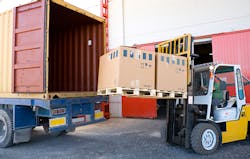Armstrong: 3PL growth in U.S. to climb yet higher
Given his recently revised estimates of market activity, consultant Evan Armstrong, president of Armstrong & Associates, now expects 3PL growth in the U.S. from 2013-2016 to accelerate beyond the pace it achieved from 2010-2013. He offered that assessment yesterday during a Stifel, Nicolaus & Co. conference call.
Armstrong attributed the rising growth in 3PL demand here and abroad to the simple fact that 3Pls “provide the infrastructure necessary to support the increasingly complex supply chains involved in [supporting] global trade”
He listed the four business segments industries that he projects will be the major contributors to global 3PL revenue growth from 2005-16 as: Industrial (10.6%), Healthcare (8.9%), Technological (8.6%) and Foods/Groceries (8.2%).
Based on his overall assessment of global trends driving decisions on plant locations and distribution routes by manufacturers, Armstrong said to expect the slowest growth in demand for 3PL services to be for International Transportation Management services while the biggest will be for domestic (U.S) Transportation Management (TM) services-- including Dedicated Contract Carriage (DCC).
DCC “has emerged as the second-fastest-growing segment this past year, and we believe this growth should continue in a capacity-constrained environment,” Stifel analysts David G. Ross and J. Bruce Chan in their follow-up remarks.
In 2013, the cost of U.S. logistics as a percentage of GDP was 8.5%, according to Armstrong. By contrast, the corresponding stats for Europe, South America and “Greater China” were 9.2%, 11.(% and 17.3%.
Armstrong reported that on a compound annual rate growth (CAGR) basis, the U.S. cost for logistics services rose 2.8% from 2010-13 and is projected to rise by 2.6% from 2013-16.
Yet, based on CAGR, while 3P revenue growth enjoyed a healthy jump of 4.5% from 2010-13, Armstrong estimates that figure will soar by 6.4% from 2013-16.
He also advised that both TM and Warehousing Management (WM) “continues to dominate 3PL demand,” with TM accounting for 23.7%, WM services for 19% and TM/WM value-added services for 18.8% of the services rendered by 3Pls.
Armstrong said above all it is the rise in both wages and manufacturing costs in China that is expected to accelerate “near-shoring” by manufacturers of automotive, high-tech and consumer-products. “The 3PLs will be where manufacturers will be and where goods will be distributed,” he remarked.
The big upshot of that, noted Stifel’s Ross and Chan, is that “re-shoring of manufacturing activity should benefit LTL carriers more than TL carriers due to its more industrial customer base.”
They also remarked that Mexico is the “preferred location for manufacturing vs. Central/South America for North American sourcing” due to it being “closer to ‘business as usual’ for U.S. companies than other Latin American countries as well as having a growing workforce and, of course, its proximity.”
It was noted that the “top commodities” now imported to the U.S from Mexico now include automotive vehicles, electrical machinery and computer-related machinery pa
